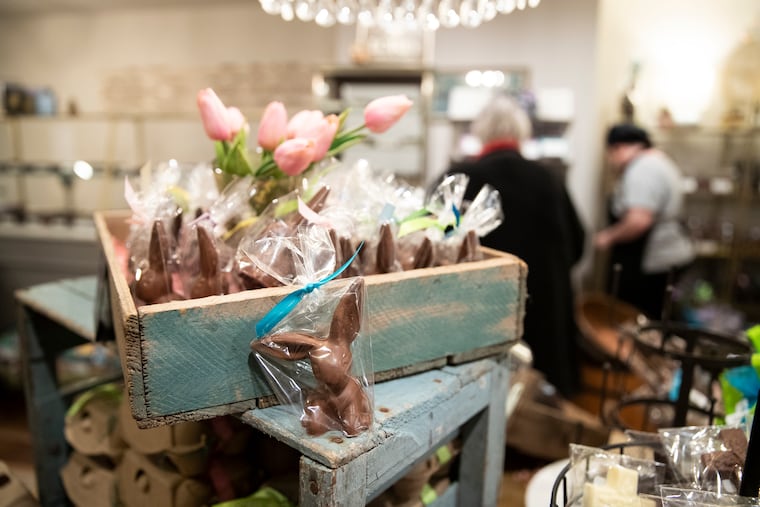Butter Krak eggs and Lore’s chocolate bunnies keep Philly Easter traditions alive, no matter the cost
Consumers are expected to spend an average of $192 per person on the holiday this year.

Zitner’s received the frantic calls in late February. Several local retailers, which buy the popular chocolate eggs from the North Philadelphia-based company, had special requests.
“They wanted more candy,” said CEO Evan Prochnaik, “significantly more candy.”
Unfortunately for egg hunters, Prochnaik and his team weren’t able to provide more chocolates before the holiday. Zitner’s typically wraps up production of its signature Easter eggs around Valentine’s Day, and ongoing supply chain issues have increased the lead time needed for the shipment of raw materials to make the candies.
The demand goes beyond coconut and buttercream.
Since the early days of COVID, when many families could not gather to celebrate holidays, candy makers, sellers, and industry experts say they have noticed an even greater hunger to continue annual rituals — from Butter Krak eggs to the traditional Easter ham — regardless of the cost.
A pandemic-induced priority shift
Consumers plan to shell out more money than ever for Easter this year — around $192 per person and about $24 billion nationwide, according to the National Retail Federation. Shoppers are prepared to drop about $3.3 billion on candy, $3.8 billion on gifts, $4 billion on clothing, and $7.3 billion on food for holiday meals. That’s up 15% from last year.
“Certainly there are a lot of factors driving spending, and we are seeing some inflation-driven categories [such as food] impacting consumers,” said Katherine Cullen, the NRF’s senior director of industry and consumer insights.
But inflation isn’t the only factor: The 15% increase in expected spending is more than double the 6% annual inflation rate as of February, the most recent month for which the data are available.
And despite the increased costs of everything from cocoa and coconut to packaging and freight, several local chocolatiers said prices have not increased much, if at all. Zitner’s, for example, did not raise prices this year, Prochnaik said, though individual stores set their own prices on Zitner’s products.
More prominently at play, Cullen said, is a pandemic-induced priority shift, one that outweighs financial concerns, at least for some who are celebrating.
Since the pandemic, people have seemed to focus more on special occasions, even when they weren’t celebrated in the usual way due to virus concerns, Cullen said. Now that restrictions are gone and many have returned to large gatherings, the rise in Easter spending shows “how much consumers are continuing to prioritize their special occasions and events and spend around them,” Cullen said.
The National Confectioners Association has noticed a similar trend, said Lauren O’Toole Boland, a spokesperson for the trade organization for chocolate and candy manufacturers.
More than $5 billion was spent on Easter candy in 2022, an increase of 9% over 2021, according to the association.
“The increase is driven largely by consumer enthusiasm,” O’Toole Boland said. “It plays such an important role when we think about Easter. … We think of jelly beans and chocolate bunnies.”
‘He still gets a bunny on a tractor.’
Local companies are waiting to see if expectations will hold true and spending will increase this year.
The Pennsylvania General Store, which has locations in Elkins Park and Reading Terminal Market, saw Easter traffic pick up late last week. The store specializes in regional products, as well as premade holiday gift baskets.
“It does tend to be a last-minute holiday,” owner Julie Holahan said. “There is not as much planning ahead as there is for Christmas.”
In Chestnut Hill, Zipf’s Candies had run out of a few items more than a week before the holiday, said manager Paula Fingerut.
Total spending is “trending about the same as last year,” she said. “But it’s hard to say until it’s all over. … It should be just as good if not a little better than last year.”
At Lore’s Chocolates in Center City, owner Tony Walter Jr. is also waiting until after the holiday to make an assessment. With some of the downtown workforce back in the office only a few days a week, foot traffic has been far more sporadic than during other holiday seasons pre-COVID, he said, but online orders remain strong.
“Because we’ve been here for so long, we’re seeing the families that always come in, and an increase with shipping,” Walter said. “Foot traffic is huge one day, and then medium one day, and then huge.”
For Lore’s, Easter sales are bolstered in part by family traditions.
Before COVID, Lore’s sold 75 different kinds of molded chocolate shapes — “bunny on train, bunny on motorcycle, bunny on a tractor,” Walter said. For practical reasons, they stopped making certain shapes that seldom got sold, he said. Yet it is often these whimsical shapes that keep customers returning year after year.
One woman recently told Walter she would pay whatever he wanted if he would make her a hollow chocolate chicken in a basket, one of the shapes that have been discontinued.
Another has ordered the same mold for her son every year for decades.
“That guy has got to be 50,” Walter said, “but he still gets a bunny on a tractor.”
“It’s that tradition for us and our customers that is so important,” he added. “People’s loyalties to the product and their traditions are very strong.”